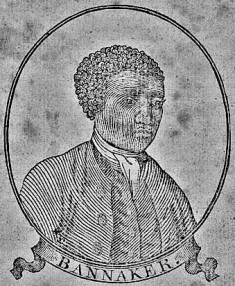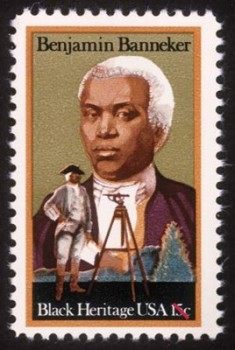| Benjamin Banneker | |
|---|---|
 |
|
| Scientist | |
| Specialty | surveyor, almanac, author, farmer |
| Born | Nov. 9, 1731 Baltimore County, Maryland |
| Died | Oct. 9, 1806 (at age 74) Baltimore County, Maryland |
| Nationality | American |
Benjamin Banneker was a famous self-educated scientist, inventor, astronomer, writer and antislavery activist. He was an African-American whose knowledge of astronomy helped him author series of almanacs that became commercially successful. He also corresponded with Thomas Jefferson on topics such as racial equality and slavery. Many abolitionists and advocates of racial equality have promoted and praised his work. Throughout the years, schools, parks, streets and many other tributes have commemorated Benjamin Banneker.
Early Life
Benjamin was born on November, 1731, in Baltimore, Maryland. His mother was African-American and she was a freed slave from Guinea. Some biographers have said that Benjamin’s mom was the daughter of Molly Welsh, a white servant and an African slave named Banneka.
As a young man, Benjamin met Peter Heinrichs who was a Quaker. The two became good friends. Quakers were great leaders in the famous anti-slavery movement and advocates of racial equality. Peter shared his library with Benjamin Banneker. When he was old enough to go to the farm, Benjamin’s education ended and he spent the rest of his life on a 100-acre piece of land.
Banneker’s Work
In 1753, at the age of 22, Benjamin completed a wooden clock which struck on the hour. He modeled this clock from a borrowed pocket watch by carving each piece to scale. His clock was even able to continue working until Benjamin’s death in 1806.
In 1759, his father died and he was left to live with his mom and sisters. He spent his time supplying the workers with food and also studying the mills. George Ellicott loaned Benjamin some books and even equipped him to help him start his formal studies in astronomy in 1788.
In February of 1791, Andrew Ellicott, another member of the family, hired Banneker to help in the initial survey of boundaries of the new federal district. This was later authorized by the 1790 federal Residence Act. The territory that later became the original District of Columbia measured 10 miles each way. This totaled 100 square miles. Ellicott and the team placed boundary stones at each and every point along the borders of this new territory.
Banneker’s Astronomical Activities
 Benjamin’s duties consisted of making astronomical observations at Jones Point in Virginia. This was to ascertain the actual location of the starting point for this survey. Benjamin also retained a clock that he used to relate points on ground to the positions of stars at specific times.
Benjamin’s duties consisted of making astronomical observations at Jones Point in Virginia. This was to ascertain the actual location of the starting point for this survey. Benjamin also retained a clock that he used to relate points on ground to the positions of stars at specific times.
At the age of 59, Benjamin Banneker left this boundary survey. His departure was due to illness and other challenges encountered while completing the survey. He went back home at Ellicott’s Mills to work on an ephemeris, which details the positions of astronomical items in the sky.
While still at Ellicott’s Mills, Benjamin made astronomical calculations that helped predict lunar and solar eclipses. He placed the ephemeris and subsequent revisions in several editions in a six-year series that was printed and sold in six cities in four states between the years 1792 and 1797.
Banneker’s Almanacs
Benjamin also kept a series of journals that contained notebooks for astronomical observations and his diary. These notebooks also contained a number of mathematical calculations and puzzles.
In his 1793 almanac, Benjamin Banneker included some letters between Thomas Jefferson and himself. The 1792 and 1793 almanacs also contained some lengthy commendations that James McHenry, one of the signers of the US Constitution, had written in 1791.
Benjamin expressed his views on racial equality and slavery in one letter to Thomas Jefferson. He also expressed his views in other documents placed within the 1793 almanac. The almanac contained copies of anti-slavery speeches, essays, and poems from America and England.
Death
Benjamin Banneker was never married. Due to declining sales, his last almanac was published in 1797. After selling most of the farm to the Ellicotts and others, he died in his log cabin on October 9, 1806. This was exactly one month before his 75th birthday. He suffered from chronic alcoholism which worsened as he aged and this may have contributed to his death.